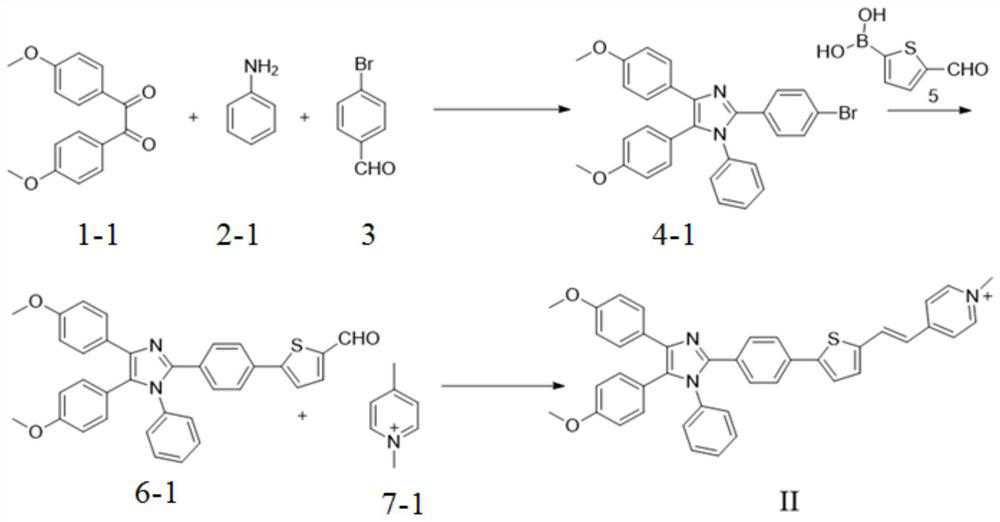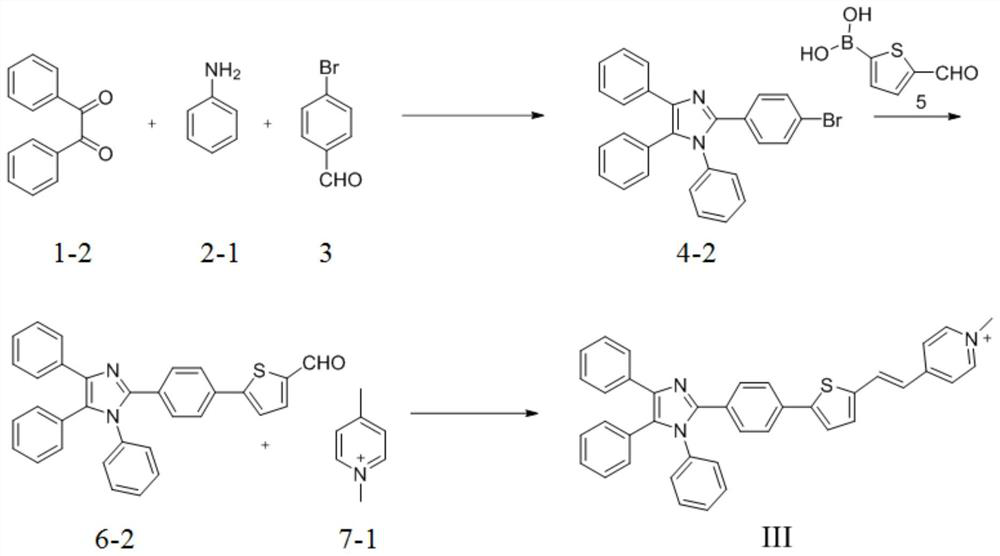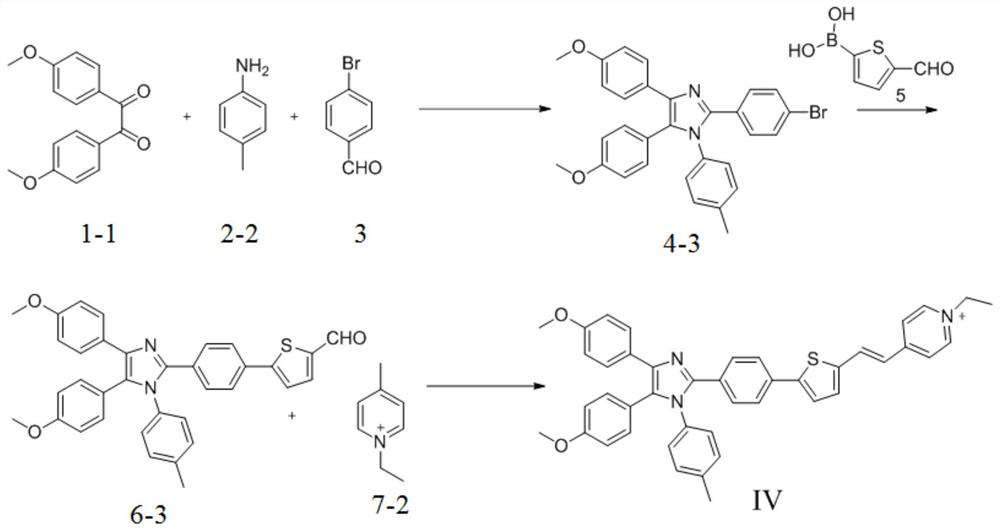A kind of wash-free glioma image fluorescent molecular probe and its preparation method and application
A fluorescent molecular probe, glioma technology, applied in fluorescence/phosphorescence, chemical instruments and methods, material analysis by optical means, etc., can solve problems such as unfavorable glioma in situ monitoring, and achieve high yield , The effect of wide detection range and low fluorescence background signal
- Summary
- Abstract
- Description
- Claims
- Application Information
AI Technical Summary
Problems solved by technology
Method used
Image
Examples
Embodiment 1
[0036] Synthesis of Fluorescent Probe II
[0037] R in the fluorescent probe structural formula prepared in this embodiment 1 =OCH 3 , R 2 = H, R 3 =CH 3 .
[0038] The synthesis technique route of present embodiment is as figure 1 As shown, it specifically includes the following steps:
[0039] Synthesis of Compound 4-1
[0040]Weigh compound 1-1 anisole (2.70g, 10mmol) and place it in a 250mL round-bottomed flask, add 40mL acetic acid, dissolve and add dropwise compound 2-1 aniline (0.93g, 10mmol) and compound 3 (1.8 g, 10mmol), stirred at 120°C for 5h, during the reaction, the reaction solution gradually changed from gray turbid liquid to light yellow clear liquid; TLC monitored the reaction process, and the dark spots of raw materials gradually decreased, and green fluorescence with relatively less polarity appeared point. After the reaction was completed, the reaction solution was poured into 200mL of water, and a yellow-gray precipitate was precipitated. After t...
Embodiment 2
[0046] Synthesis of Fluorescent Probe III
[0047] R in the fluorescent probe structural formula prepared in this embodiment 1 = H, R 2 = H, R 3 =CH 3 .
[0048] The synthesis technique route of present embodiment is as figure 2 As shown, it specifically includes the following steps:
[0049] Synthesis of Compound 4-2
[0050] Weigh compound 1-2 benzil (2.10g, 10mmol) and place it in a 250mL round bottom flask, add 40mL acetic acid, dissolve and add compound 2 aniline (0.93g, 10mmol) and compound 3 (1.8g, 10mmol), stirred at 120°C for 5h. During the reaction, the reaction solution gradually changed from gray turbid liquid to light yellow clear liquid; TLC monitored the reaction process, and the dark spots of raw materials gradually decreased, and blue fluorescent spots with relatively less polarity appeared. . After the reaction was completed, the reaction solution was poured into 200mL of water, and a yellow-gray precipitate was precipitated. After the system was adj...
Embodiment 3
[0056] Synthesis of Fluorescent Probe III
[0057] R in the fluorescent probe structural formula prepared in this embodiment 1 =OCH 3 , R 2 =CH 3 , R 3 =CH 2 CH 3 .
[0058] The synthesis technique route of present embodiment is as image 3 As shown, it specifically includes the following steps:
[0059] Synthesis of compound 4-3
[0060] Weigh compound 1-1 anisole (2.70g, 10mmol) and place it in a 250mL round-bottomed flask, add 40mL acetic acid, dissolve and add compound 2-2 p-methylaniline (1.07g, 10mmol) dropwise under stirring at room temperature and compound 3 (1.8g, 10mmol), stirred at 120°C for 5h, during the reaction, the reaction solution gradually changed from gray turbid liquid to light yellow clear liquid; TLC monitored the reaction process, the dark spots of raw materials gradually decreased, and the relative polarity appeared smaller green fluorescent dots. After the reaction was completed, the reaction solution was poured into 200mL of water, and a y...
PUM
 Login to View More
Login to View More Abstract
Description
Claims
Application Information
 Login to View More
Login to View More - R&D
- Intellectual Property
- Life Sciences
- Materials
- Tech Scout
- Unparalleled Data Quality
- Higher Quality Content
- 60% Fewer Hallucinations
Browse by: Latest US Patents, China's latest patents, Technical Efficacy Thesaurus, Application Domain, Technology Topic, Popular Technical Reports.
© 2025 PatSnap. All rights reserved.Legal|Privacy policy|Modern Slavery Act Transparency Statement|Sitemap|About US| Contact US: help@patsnap.com



